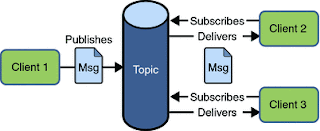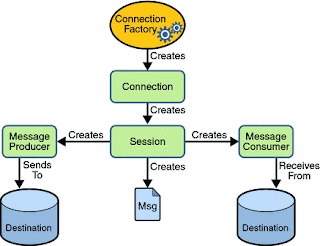jms activemq_带有ActiveMQ的JMS
jms activemq
JMS是Java消息服务的缩写,它提供了一种以松散耦合,灵活的方式集成应用程序的机制。 JMS以存储和转发的方式跨应用程序异步传递数据。 应用程序通过充当中介的MOM(面向消息的中间件)进行通信,而无需直接通信。
JMS体系结构
JMS的主要组件是:
- JMS Provider:一种消息传递系统,它实现JMS接口并提供管理和控制功能
- 客户端:发送或接收JMS消息的Java应用程序。 消息发送者称为生产者,而接收者称为消费者
- 消息:在JMS客户端之间传递信息的对象
- 受管对象:管理员为使用客户端而创建的预配置JMS对象。
有几种可用的JMS提供程序,例如Apache ActiveMQ和OpenMQ。 在这里,我使用了Apache ActiveMQ。
在Windows上安装和启动Apache ActiveMQ
- 下载ActiveMQ Windows二进制分发版
- 将其提取到所需位置
- 使用命令提示符将目录更改为ActiveMQ安装文件夹中的bin文件夹,然后运行以下命令以启动ActiveMQ
activemq

启动ActiveMQ之后,您可以使用http:// localhost:8161 / admin /访问管理控制台并执行管理任务
JMS消息传递模型
JMS有两种消息传递模型,即点对点消息传递模型和发布者订户消息传递模型。
点对点消息传递模型
生产者将消息发送到JMS提供程序中的指定队列,并且只有一个监听该队列的使用者才能接收该消息。

示例1和示例2几乎相似,唯一的区别是示例1在程序内创建队列,示例2使用jndi.properties文件命名查找和创建队列。
例子1
package com.eviac.blog.jms;import javax.jms.*;
import javax.naming.InitialContext;
import javax.naming.NamingException;import org.apache.log4j.BasicConfigurator;public class Producer {public Producer() throws JMSException, NamingException {// Obtain a JNDI connectionInitialContext jndi = new InitialContext();// Look up a JMS connection factoryConnectionFactory conFactory = (ConnectionFactory) jndi.lookup('connectionFactory');Connection connection;// Getting JMS connection from the server and starting itconnection = conFactory.createConnection();try {connection.start();// JMS messages are sent and received using a Session. We will// create here a non-transactional session object. If you want// to use transactions you should set the first parameter to 'true'Session session = connection.createSession(false,Session.AUTO_ACKNOWLEDGE);Destination destination = (Destination) jndi.lookup('MyQueue');// MessageProducer is used for sending messages (as opposed// to MessageConsumer which is used for receiving them)MessageProducer producer = session.createProducer(destination);// We will send a small text message saying 'Hello World!'TextMessage message = session.createTextMessage('Hello World!');// Here we are sending the message!producer.send(message);System.out.println('Sent message '' + message.getText() + ''');} finally {connection.close();}}public static void main(String[] args) throws JMSException {try {BasicConfigurator.configure();new Producer();} catch (NamingException e) {e.printStackTrace();}}
}package com.eviac.blog.jms;import javax.jms.*;import org.apache.activemq.ActiveMQConnection;
import org.apache.activemq.ActiveMQConnectionFactory;
import org.apache.log4j.BasicConfigurator;public class Consumer {// URL of the JMS serverprivate static String url = ActiveMQConnection.DEFAULT_BROKER_URL;// Name of the queue we will receive messages fromprivate static String subject = 'MYQUEUE';public static void main(String[] args) throws JMSException {BasicConfigurator.configure();// Getting JMS connection from the serverConnectionFactory connectionFactory = new ActiveMQConnectionFactory(url);Connection connection = connectionFactory.createConnection();connection.start();// Creating session for seding messagesSession session = connection.createSession(false,Session.AUTO_ACKNOWLEDGE);// Getting the queueDestination destination = session.createQueue(subject);// MessageConsumer is used for receiving (consuming) messagesMessageConsumer consumer = session.createConsumer(destination);// Here we receive the message.// By default this call is blocking, which means it will wait// for a message to arrive on the queue.Message message = consumer.receive();// There are many types of Message and TextMessage// is just one of them. Producer sent us a TextMessage// so we must cast to it to get access to its .getText()// method.if (message instanceof TextMessage) {TextMessage textMessage = (TextMessage) message;System.out.println('Received message '' + textMessage.getText()+ ''');}connection.close();}
}
jndi.properties
# START SNIPPET: jndijava.naming.factory.initial = org.apache.activemq.jndi.ActiveMQInitialContextFactory# use the following property to configure the default connector
java.naming.provider.url = vm://localhost# use the following property to specify the JNDI name the connection factory
# should appear as.
#connectionFactoryNames = connectionFactory, queueConnectionFactory, topicConnectionFactry# register some queues in JNDI using the form
# queue.[jndiName] = [physicalName]
queue.MyQueue = example.MyQueue# register some topics in JNDI using the form
# topic.[jndiName] = [physicalName]
topic.MyTopic = example.MyTopic# END SNIPPET: jndipackage com.eviac.blog.jms;import javax.jms.*;
import javax.naming.InitialContext;
import javax.naming.NamingException;import org.apache.log4j.BasicConfigurator;public class Producer {public Producer() throws JMSException, NamingException {// Obtain a JNDI connectionInitialContext jndi = new InitialContext();// Look up a JMS connection factoryConnectionFactory conFactory = (ConnectionFactory) jndi.lookup('connectionFactory');Connection connection;// Getting JMS connection from the server and starting itconnection = conFactory.createConnection();try {connection.start();// JMS messages are sent and received using a Session. We will// create here a non-transactional session object. If you want// to use transactions you should set the first parameter to 'true'Session session = connection.createSession(false,Session.AUTO_ACKNOWLEDGE);Destination destination = (Destination) jndi.lookup('MyQueue');// MessageProducer is used for sending messages (as opposed// to MessageConsumer which is used for receiving them)MessageProducer producer = session.createProducer(destination);// We will send a small text message saying 'Hello World!'TextMessage message = session.createTextMessage('Hello World!');// Here we are sending the message!producer.send(message);System.out.println('Sent message '' + message.getText() + ''');} finally {connection.close();}}public static void main(String[] args) throws JMSException {try {BasicConfigurator.configure();new Producer();} catch (NamingException e) {e.printStackTrace();}}
}package com.eviac.blog.jms;import javax.jms.*;
import javax.naming.InitialContext;
import javax.naming.NamingException;import org.apache.log4j.BasicConfigurator;public class Consumer {public Consumer() throws NamingException, JMSException {Connection connection;// Obtain a JNDI connectionInitialContext jndi = new InitialContext();// Look up a JMS connection factoryConnectionFactory conFactory = (ConnectionFactory) jndi.lookup('connectionFactory');// Getting JMS connection from the server and starting it// ConnectionFactory connectionFactory = new// ActiveMQConnectionFactory(url);connection = conFactory.createConnection();// // Getting JMS connection from the server// ConnectionFactory connectionFactory = new// ActiveMQConnectionFactory(url);// Connection connection = connectionFactory.createConnection();try {connection.start();// Creating session for seding messagesSession session = connection.createSession(false,Session.AUTO_ACKNOWLEDGE);// Getting the queueDestination destination = (Destination) jndi.lookup('MyQueue');// MessageConsumer is used for receiving (consuming) messagesMessageConsumer consumer = session.createConsumer(destination);// Here we receive the message.// By default this call is blocking, which means it will wait// for a message to arrive on the queue.Message message = consumer.receive();// There are many types of Message and TextMessage// is just one of them. Producer sent us a TextMessage// so we must cast to it to get access to its .getText()// method.if (message instanceof TextMessage) {TextMessage textMessage = (TextMessage) message;System.out.println('Received message '' + textMessage.getText()+ ''');}} finally {connection.close();}}public static void main(String[] args) throws JMSException {BasicConfigurator.configure();try {new Consumer();} catch (NamingException e) {// TODO Auto-generated catch blocke.printStackTrace();}}
}
发布者订阅者模型
发布者将消息发布到JMS提供程序中的指定主题,并且订阅该主题的所有订阅者都将收到该消息。 请注意,只有活动的订户才能收到该消息。

点对点模型示例
package com.eviac.blog.jms;import javax.jms.*;
import javax.naming.*;import org.apache.log4j.BasicConfigurator;import java.io.BufferedReader;
import java.io.InputStreamReader;public class DemoPublisherSubscriberModel implements javax.jms.MessageListener {private TopicSession pubSession;private TopicPublisher publisher;private TopicConnection connection;/* Establish JMS publisher and subscriber */public DemoPublisherSubscriberModel(String topicName, String username,String password) throws Exception {// Obtain a JNDI connectionInitialContext jndi = new InitialContext();// Look up a JMS connection factoryTopicConnectionFactory conFactory = (TopicConnectionFactory) jndi.lookup('topicConnectionFactry');// Create a JMS connectionconnection = conFactory.createTopicConnection(username, password);// Create JMS session objects for publisher and subscriberpubSession = connection.createTopicSession(false,Session.AUTO_ACKNOWLEDGE);TopicSession subSession = connection.createTopicSession(false,Session.AUTO_ACKNOWLEDGE);// Look up a JMS topicTopic chatTopic = (Topic) jndi.lookup(topicName);// Create a JMS publisher and subscriberpublisher = pubSession.createPublisher(chatTopic);TopicSubscriber subscriber = subSession.createSubscriber(chatTopic);// Set a JMS message listenersubscriber.setMessageListener(this);// Start the JMS connection; allows messages to be deliveredconnection.start();// Create and send message using topic publisherTextMessage message = pubSession.createTextMessage();message.setText(username + ': Howdy Friends!');publisher.publish(message);}/** A client can register a message listener with a consumer. A message* listener is similar to an event listener. Whenever a message arrives at* the destination, the JMS provider delivers the message by calling the* listener's onMessage method, which acts on the contents of the message.*/public void onMessage(Message message) {try {TextMessage textMessage = (TextMessage) message;String text = textMessage.getText();System.out.println(text);} catch (JMSException jmse) {jmse.printStackTrace();}}public static void main(String[] args) {BasicConfigurator.configure();try {if (args.length != 3)System.out.println('Please Provide the topic name,username,password!');DemoPublisherSubscriberModel demo = new DemoPublisherSubscriberModel(args[0], args[1], args[2]);BufferedReader commandLine = new java.io.BufferedReader(new InputStreamReader(System.in));// closes the connection and exit the system when 'exit' enters in// the command linewhile (true) {String s = commandLine.readLine();if (s.equalsIgnoreCase('exit')) {demo.connection.close();System.exit(0);}}} catch (Exception e) {e.printStackTrace();}}
}

参考: 和ActiveMQ JMS从我们JCG伙伴 Pavithra Siriwardena在EVIAC博客。
翻译自: https://www.javacodegeeks.com/2012/07/jms-with-activemq.html
jms activemq
jms activemq_带有ActiveMQ的JMS相关推荐
- 带有ActiveMQ的JMS
带有ActiveMQ的JMS JMS是Java Message Service的缩写,它提供了一种以松散耦合,灵活的方式集成应用程序的机制. JMS以存储和转发的方式跨应用程序异步传递数据. 应用程序 ...
- python消息中间件activemq_消息中间件ActiveMQ和JMS基础
MQ主要流程 解耦,异步,消峰 其中目的地主要为队列或者主题 队列点对点 消息的生产者 或者 这时消息的生产者名字已经出来 并且入队的数量变成了3 上述完成的也就是这部分 消息的消费者 前四步大同小异 ...
- activemq和jms_带有ActiveMQ和Maven的JMS Sender应用程序
activemq和jms 我们已经看到了如何使用ActiveMQ和Maven创建JMS Receiver应用程序 . 让我们看看我们如何类似地创建JMS Sender应用程序 . web.xml与创建 ...
- 带有ActiveMQ和Maven的JMS Sender应用程序
我们已经看到了如何使用ActiveMQ和Maven创建JMS Receiver应用程序 . 让我们看看我们如何类似地创建JMS Sender应用程序 . web.xml与创建接收器应用程序时使用的相同 ...
- JMS规范、ActiveMQ Broker和ActiveMQ传输协议
Java实现ActiveMQ通讯(构建过程) 编写pom.xml配置文件 <!-- https://mvnrepository.com/artifact/org.apache.activemq/ ...
- JMS学习(2):ActiveMQ简单介绍以及安装
现实的企业中,对于消息通信的应用一直都非常的火热,而且在J2EE的企业应用中扮演着特殊的角色,所以对于它研究是非常有必要的. 上篇博文深入浅出JMS(一)–JMS基本概念,我们介绍了消息通信的规范JM ...
- activemq和jms_保证主题,JMS规范和ActiveMQ的消息传递
activemq和jms 最近,一位客户要求我仔细研究ActiveMQ的"持久"消息的实现,它如何应用于主题以及在存在非持久订户的故障转移方案中会发生什么. 我已经了解到,JMS语 ...
- 保证主题,JMS规范和ActiveMQ的消息传递
最近,一个客户要求我仔细研究ActiveMQ的"持久"消息的实现,它如何应用于主题以及在存在非持久订阅者的故障转移方案中会发生什么. 我已经了解到,JMS语义规定,即使面对消息代理 ...
- 使用Apache ActiveMQ的JMS开发基础
去年是我尝试JMS的时候. 背后的想法和概念让我有些困惑,但是当我知道它的用途后,我很快就掌握了它. 在本文中,我将展示使用Apache ActiveMQ作为后端使用Java开发简单的生产者/消费者的 ...
最新文章
- 【CV】吴恩达机器学习课程笔记 | 第1-15章
- JQuery 实现遮罩层
- Cacti如何实现电话告警
- Android使用SAX解析XML(6)
- 2009年北京突然的一场雪
- elasticsearch 根据条件更新数据
- pymysql 返回数据为字典形式(key:value--列:值)
- 求最长上升子序列(Lis模板)
- 本地邮件系统的安装及配置
- SqlServer查询表名的备注(查询表名描述 MS_Description)
- Julia:last() 和first()
- java多线程小游戏_java控制台贪吃蛇小游戏(多线程版)
- php如何安装pdflib,使用pdflib及PHP生成pdf文件(文件内容中有中文)的方法
- 网络速度在线测试软件,在线网速测试(局域网速度测试工具)
- 设置背景颜色html,css怎么设置背景颜色?
- linux 独立冗余磁盘阵列,独立冗余磁盘列阵
- java eclipse计算器_eclipse编写计算器
- IP、Route相关命令基础知识
- 【数据库】四(1)、数据查询之单表查询
- 百草味爆发性增长的秘密:5%靠营销,95%靠产品
